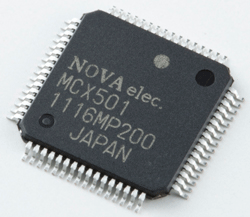- HOME
- Motion Contorol ICs
- MCX501
MCX501-High performance 1-Axis Motion Control IC

- Speed range-freeNew!
- Various acceleration/deceleration driving mode
- Various synchronous actions
- Built in timerNew!
- Split pulseNew!
- Automatic home search
- Integral input filter built-in
- Maximum drive speed 8Mpps (When CLK is 20MHz, maximum speed is 10Mpps.)
- Package size 64 pin QFP
Speed range-free
MCX501 is epoch-making motion control IC which can set the drive speed by a 1pps unit from 1pps to 8Mpps without range setting (range-free).
When setting the drive speed by using speed multiple (Range setting),
・ Setting multiple small for precise speed setting at low speed → It can not shift to high speed drive.
・ Setting multiple large for high speed drive → It can not set precise drive speed.
There were the above limitations for the previous ICs.
By speed range free, such inconveniences have been taken away and MCX501 can change the speed directly from low speed, like 1pps, 2pps to high speed pulse, 1Mpps during driving.

Various acceleration/deceleration driving mode
MCX501 can perform various acceleration/deceleration driving, such as constant speed drive, trapezoidal acceleration/deceleration drive(symmetrical/non-symmetrical), S-curve acceleration/deceleration drive (Symmetrical/non-symmetrical).
●Starting of automatic deceleration
In position drive of trapezoidal acceleration/deceleration (symmetrical/non-symmetrical) and S-curve acceleration/deceleration (symmetrical only), MCX501 calculates the deceleration start point and starts deceleration drive automatically. (Non-symmetrical S-curve acceleration/deceleration driving is excluded.)
●S-curve acceleration/deceleration
In S-curve acceleration/deceleration, a primary linear increase/decrease method is applied. Therefore the speed acceleration/deceleration profile forms parabolic S-curve. Triangle waveforms during S-curve acceleration/deceleration are prevented by a special method.

Various synchronous actions
Synchronous action is can be set to 4-set. Composition of 1-set is a specified activation factor and a specified action. There are 15 types of activation factor, such as the passage of the specified position, start/stop of driving, the rising/falling of the external input signal and expiring of the built-in timer and so on. As a specified action, there are 28 types, such as start/stop of driving, saving a value of current position counter and writing the speed of driving and so on. To set the multiple sets of synchronous action, various kinds of applications can be executed.

- Output the external signal when passing the specified point during driving.
- Save the current position to the specified register when the external signal is input during driving.
- N pcs. of split pulse is output from the specified position to the external during driving, and so on.
Built-in timer
Various actions are possible in combination with synchronous action as follows.

- After a drive ends, next drive starts after waiting specified time.
- After the external signal is input, a drive starts after waiting specified time.
- Stop continuous drive after specified time.
- Measure the driving time from the passage point A from the point B. and so on.
Split Pulse
Synchronizing an axis driving, the various actions can be performed in specified interval.
This function can set spilt length, pulse width and pulse number. Additionally, in combination with synchronous action, split pulse starts/stops at the specified position, split length and pulse width can be changed by the external signal input.

